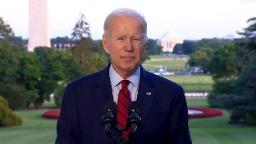

The US drone strike that killed al-Qaeda leader Ayman al-Zawahiri on his balcony in Kabul over the weekend was the product of months of highly secret planning by President Biden and a tight circle of his senior advisers, who constructed a small scale model of Zawahiri’s safe-house for Biden to examine inside the White House Situation Room as he considered his options.
Details of the strike and its planning were disclosed by a senior administration official as Biden was preparing to announce the mission Monday.
Here are key things to know:
- The President was first briefed in April on US intelligence placing Zawahiri at a safe house in Kabul. American officials had been aware of a network supporting the terrorist leader in the Afghan capital for months, and had identified his wife, daughter and her children through multiple streams of intelligence.
- The women utilized terrorist “tradecraft” that officials deemed designed to prevent anyone from following them to Zawahiri’s location in a Kabul neighborhood. Zawahiri himself didn’t leave the location after his arrival this year.
- As the months wore on, US officials began to establish patterns at the house — including Zawahiri emerging periodically onto the home’s balcony for sustained periods of time.
- As officials continued to monitor his activities, an effort began in complete secret to analyze the building’s construction and structure, with an eye toward developing an operation to take out the world’s No. 1 terrorist target without compromising the building’s structural integrity.
- At top of mind for Biden and members of his team was avoiding civilian deaths, including the members of Zawahiri’s family who were living in the building. Independent analysis from across the government were involved in identifying the other occupants of the house.
- The fact that the building was located in downtown Kabul presented its own challenges as it was surrounded by a residential neighborhood. Officials were mindful their planning and information needed to be “rock solid” before presenting any options to Biden. And they were highly wary of leaks; only a “very small and select group” at a scattering of key agencies were informed of the plans being laid.
- As May and June wore on, Biden was kept abreast of the developments. On July 1, he gathered key national security officials in the White House Situation Room to receive a briefing on a proposed operation. CIA Director Bill Burns, Director of National Intelligence Avril Haines, national security adviser Jake Sullivan and his deputy Jon Finer, and Homeland Security adviser Liz Sherwood Randall sat around the table.
On Biden’s role in the mission: Biden was “deeply engaged in the briefing and immersed in the intelligence,” a senior official said. He asked “detailed questions about what we knew and how we knew it.”
Of particular interest was a scale model of Zawahiri’s house that intelligence officials had constructed and brought into the White House for the President to examine. Biden questioned how the house might be lit by the sun, its construction materials and how the weather could affect any operation, the official said.
“He was particularly focused on ensuring that every step had been taken to ensure the operation would minimize that risk” of civilian casualties, according to the official.
Biden asked his team for more information about the building’s plans and how a strike might effect it. He flew to Camp David later that afternoon.
His team remained behind, convening multiple times in the Situation Room over the next weeks to complete their planning, answer the President’s questions and ensure they’ve taken every contingency to minimize risks.
A parallel effort by senior administration lawyers was underway to examine the intelligence related to Zawahiri and establish the legal basis for the operation.
On July 25 — as he was isolating with Covid-19 in the White House residence — Biden brought his team back together to receive a final briefing. He again pressed at a “granular level,” the official said, asking about any additional options that could minimize civilian casualties.
He asked about the layout of the house — where the rooms were positioned behind windows and doors on the third floor — and what potential impact the strike would have.
And he went around his team, asking each official’s view.
At the end, he authorized a “precise tailored airstrike” to take out the target.
Five days later, two Hellfire missiles were fired into the balcony of the safe-house in Kabul. “Multiple streams of intelligence” confirmed Zawahiri was killed.
Members of his family, who were in other areas of the home, were unharmed, the official said.
Biden, still isolating in the White House residence with a rebound Covid infection, was informed when the operation began and when it concluded.
